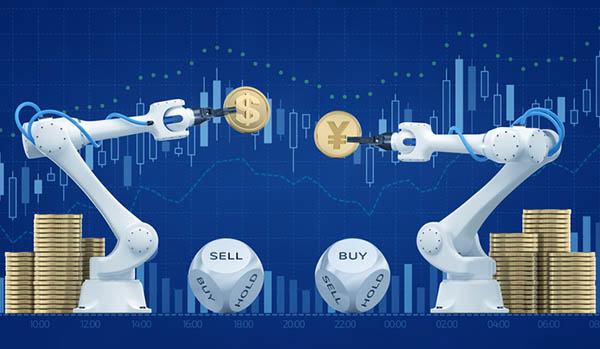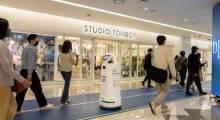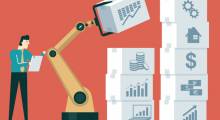While robotics developers and warehouse operators might be familiar with a host of technical or industry acronyms, the terminology of the financial industry is another language altogether. Yet ETFs, CAGR, and SPACs are just as important as AI, AMRs, or ASRS. What do investors look for in robotics startups, and how can users identify promising or maturing technologies? Rahul Sen Sharma, managing partner at Indxx, has been following robotics, automation, and artificial intelligence with those questions in mind.
Founded in 2005, Indxx provides client and custom indexes tracking emerging technologies. The company, which has offices in New York, New Delhi, and Miami, watches market trends to help investors build portfolios such as one around automation.
Robotics 24/7 spoke with Sharma about how investors see robotics innovation and applications. Note the companies cited here are not recommended investments, just examples of robotics trends.

ETFs emerge around automation
There aren't many exchange-traded funds (ETFs) for robotics, automation, and AI—why is that?
Sharma: Robotics, automation, and AI is a growing field which recently has gained a lot of interest owing to digitization, labor shortages, and the pandemic. Due to the varied nature of the field, early-stage investments in robotics made by VCs [venture capital firms] have generally generated poor returns over time.
However, as robotics and AI technology has developed and new application areas have emerged, we are seeing profitability, success, and more ETFs based on the theme. In the U.S., there are well over half-a-dozen ETFs focused on robotics and/or AI.
The largest ETF in the U.S. is BOTZ, which tracks our Indxx Global Robotics & Artificial Intelligence Thematic Index and has AUM [assets of under management] of $ 1.65 billion (as of April 29, 2022). It is designed to track the performance of companies that are expected to benefit from the increased adoption and utilization of robotics and AI.
What has your index done that's unique?
Sharma: What makes our index unique is that, instead of focusing on robotics companies, we are more focused towards companies where robotics and AI would find applications leading to global exposure across multiple sectors and industries.
Robots evolve for new sectors
While much of the focus on industrial automation is in automotive, are there any other areas where you think robotics will be especially helpful in the near future?
Sharma: Supply chain and logistics: Autonomous mobile robots [AMRs] are helping define the supply chain of the future by helping companies decrease long-term costs, provide labor and utilization stability, increase worker productivity, reduce error rates, and reduce frequency of inventory checks.
Robots can also optimize picking, sorting, and storing times and increase access to difficult or dangerous locations.
Food manufacturing and food processing: Primary processing and secondary processing applications are increasingly using industrial and collaborative robots.
The introduction of more advanced grippers has boosted robotics applications within the food-processing industry. These grippers allow for quick but gentle handling of sensitive food products like fruit and vegetables.
Robots can also be used to automate food packaging and food delivery, with companies such as Marble [acquired in 2020 by Caterpillar] and Dispatch [acquired by Amazon in 2017] exploring this space.
Are there certain types of robots where you expect strong growth? Any that are overhyped?
Sharma: Articulated robots: Robotic arms, also known as articulated robots, are fast, reliable, and accurate and can be programmed to do an infinite number of tasks in a variety of environments. They are used in factories to automate execution of repetitive tasks, such as applying paint to equipment or parts.
In warehouses, robot arms pick, select, or sort goods from distribution conveyors to fulfill customer orders. On farms, they can pick and place ripe fruits onto trays in the field.
Humanoids: Humanoid robots have garnered huge interest in recent years owing to their human-like appearance and exciting capabilities. Companies such as Tesla, Toyota Research Institute, and Hanson Robotics have seen investments in developing the robots that have generated the buzz.
The investment environment is also changing
While the robotics space has been relatively healthy, we've seen reports on there being fewer early-stage investments, as well as some consolidation. Is that normal?
Sharma: Any disruptive technology can undergo stages of development which are likely to impact the investment in the area. Robotics is a field where the initial investments required are very high which increases the risk. While VCs have invested heavily in the area in the past, the lack of big returns on investments coupled with the lack of any major profitable unicorn startup has been a cause of concern. This can largely be attributed to VCs and startups:
- Overestimating the robotics technological capabilities.
- Developing solutions which end up being more expensive than the problem that they were trying to solve.
In fact, many early-stage robotic companies have folded or have undergone mergers and acquisitions.
Regardless of a few VC firms being skeptical of the robotics space, capital is still largely abundant, and die-hard robotics investors and other affiliates continue to make gargantuan investments.
In addition, the robotics startups emerging nowadays are going after small and medium-sized businesses with real automation needs, broadening their market footprint beyond e-commerce, focusing on simpler use cases and adopting a robots-as-a-service [RaaS] business model with zero upfront costs.
Last year, we saw a lot of activity around special-purpose acquisition corporations (SPACs) in robotics and autonomous vehicles (AVs). Do you think that trend is likely to continue?
Sharma: Yes. The trend of investments in robotics and AVs is likely to continue, as the development of technology accelerates and they find applications in new areas. For instance, AV application areas are increasing, especially in self-driving cars and robotaxis, military supply chain and logistics, and last-mile delivery.
Similarly, the use of robots is increasing across a diverse set of industries such as healthcare, space exploration, and construction. The rapid development in technology, coupled with increasing usage of robotics, is sure to continue attracting investment.
Self-driving cars, COVID-19 shape robotics
We've talked before about the potential for robotics in general to benefit from the money currently pouring into AV development. Have you seen any of that happen yet?
Sharma: The field of robotics has immense application in the development of autonomous vehicles. As such, investments in the AV market have benefited companies primarily engaged in robotics. Self-driving technologies such as ADAS [advanced driver-assist systems] and lidar have boosted investment in robotics.
Large automakers such as Ford, BMW, Honda, and General Motors have been investing heavily in the development of robotics technology, along with tech companies such as Google, NVIDIA, and Intel.
New-age AV startups such as Zoox, AutoX, and Optimus Ride have attracted huge investments. In addition, as AV companies grow to meet the challenge of human-robot collaboration at the level required to bring self-driving vehicles to market, the horizon for leveraging these solutions for other robotics applications could expand.
There has been a lot of interest in delivery and disinfection systems during the pandemic, but are they sustainable as consumer habits shift again?
Sharma: The ongoing coronavirus pandemic has increased an interest in robots, drones, and AI owing to their application in delivery and disinfection systems.
Both companies as well as consumers have greatly benefited from the implementation of robotics. The increased awareness among the public regarding hygiene, and the improved efficiency in delivery and logistics enabled via robotics is likely to continue even as consumer habits shift post-pandemic.
As the pandemic slows down, we are seeing the increasing usage of robotics and automation in hospitals, public spaces, etc. Additionally, robotic technologies would continue to find usage while dealing with massive staffing shortages in healthcare, manufacturing, and supply chains; the need for “social distancing”; and diagnosis and treatment.
Applications, software help innovators stand out
What should investors look for as they sift through the plethora of robotics startups?
Sharma: While analyzing an investment opportunity in the robotics space, investors should consider the following criteria:
- Companies that make core automation and robotics technology
- Companies that make technologies and components that work with or in robotics
- Industrial software companies, which are/would be an integral part of the small automation revolution and the segment in which the highest growth rates are likely to be found
- Companies that are using robotics and smart automation to enhance their product offerings to existing customers
Alternatively, for investors looking to invest into the robotics sector rather than a single company, check out ETFs such as the Global X Robotics & Artificial Intelligence ETF (NASDAQ: BOTZ).
About the Author
Follow Robotics 24/7 on Linkedin
Article topics
Email Sign Up
















